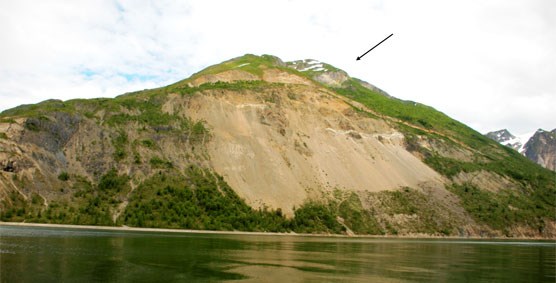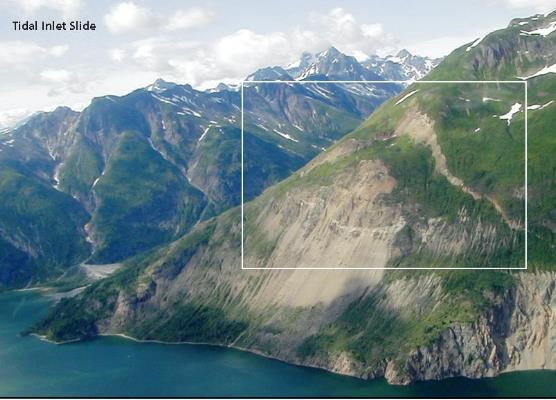
Natural Processes at WorkThe landscape of Glacier Bay National Park and Preserve is ever changing. The park’s glaciers, steep rugged slopes, and magnificent views attract over 400,000 visitors each year. Glacier Bay is also a natural laboratory drawing scientists from around the world to study its dynamic environment. The natural processes that formed this impressive terrain are still very much at work. Recently released from the grip of glacier ice, this newly exposed landscape is being shaped by water, ice, gravity, as well as biological and tectonic processes. When these processes coincide with human activities they can present potential hazards to human safety. Quakes, Slippery Slopes, and Giant WavesIn the last 250 years, rapid de-glaciation of southern Alaska has removed significant masses of ice from the earth’s surface. Released from under the immense weight of ice, the land is now rebounding upward, leading to shifts in streambeds, erosion, and sedimentation. Generally, heavy glacial ice weight suppresses earthquakes, while deglaciation promotes them. Consequently, the region may be experiencing an increase in seismic activity. Earthquakes can intensify landscape movements such as landslides, and landslides falling into the ocean can generate large tsunami waves. One of the most conspicuous examples of this is found at Lituya Bay. In July 1958 an earthquake of about magnitude 8 on the Richter Scale shook loose an estimated 40 million cubic yards of dirt and glacial ice from the head of Lituya Bay. When the landslide hit the water it generated a massive wave that washed 1,700 feet up a nearby slope and inundated about 5 square miles of land along the shores of the bay. The wall of water sank two fishing boats, killed two people, and traveled as far as 3,600 feet inland, decimating millions of trees. This wave, the largest ever recorded, was not the first. Lituya Bay has a history of large landslides and giant waves. Tlingit oral tradition tells of an entire village that was swept away and physical evidence shows that at least three landslide-generated large waves occurred between 1853 and 1936. The combination of recent deglaciation, relatively frequent earthquakes, steep rocky slopes, and narrow inlets, suggests that many locations in Glacier Bay still have the potential for generating large waves. 
Tidal InletTidal inlet is one such place. When the glaciers of the Little Ice Age began retreating from Tidal Inlet they took with them the lateral support of the hillsides. This loss of support weakened the slope, and between 1892 and 1919 a large landslide on the north slope of the Inlet began to move. Around 1899 and 1900 the area also experienced large-magnitude earthquakes (8.1 to 8.5 on the Richter Scale) that may have trig-gered additional movement.Today, the Tidal Inlet slide is easily observed as a barren scar of sediment and bedrock approximately half-way up Glacier Bay’s West Arm. Even a casual observer can identify the unstable nature of this hillside and wonder whether it is moving, and if so, how fast. Although there are other potential landslide areas along the shores of Glacier Bay, scientists have been watching Tidal Inlet carefully for several years. Monitoring Tidal InletFrom 2002– 2004 geologists measured the body of the slide, installed markers to carefully identify any motion, and collected highly precise data using GPS equipment. 

What Can I Do?Understand that dynamic processes are continuing to shape Glacier Bay. Recently released from the grip of glacier ice, this newly exposed landscape is still being shaped by water, ice, gravity, as well as biological and tectonic processes.Be aware of your surroundings. Landslides and unstable cliff faces occur throughout Glacier Bay. They are inherently unpredictable, and major events may occur at any time. If you suspect an earthquake has occurred, contact the US Coast Guard or listen to mariner radio reports. Make sure that conditions are safe for navigation and anchoring. Even though it is safer to be in deep water (>1,200 feet) than to be moored in a cove or harbor, in the event of a locally-generated tsunami there won’t be time to motor a boat to deep water. If possible, leave your boat moored and climb to higher ground. |
Last updated: June 5, 2018
